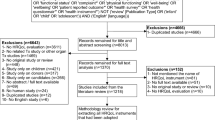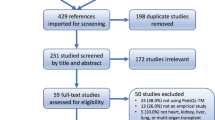Abstract
Purpose
Health-related quality of life (HRQL) domains vary across disease conditions and are determined by standards, values, and priorities internal to patients. Although the clinical goals of lung transplantation are to improve patient survival and HRQL, what defines HRQL in lung transplantation is unknown. Employing a qualitative approach, we aimed to identify HRQL domains important in lung transplantation.
Methods
We conducted semi-structured interviews in purposefully sampled lung transplant recipients (n = 8) representing a spectrum of ages, gender, indications for transplantation, and time since transplantation as well as healthcare practitioners representing a spectrum of practitioner types (n = 9). Grounded theory was used to identify HRQL domains important in lung transplantation, building on but going beyond domains already defined in the SF-36, the most commonly used instrument in this population.
Results
In addition to confirming the relevance of the eight SF-36 domains, we identified 11 novel HRQL domains. Palliation of respiratory symptoms was identified as important. After transplant surgery, new HRQL domains emerged including: distressing symptoms spanning multiple organ systems, worry about infection and acute rejection, treatment burden, and depression. Further, patients identified challenges to intimacy, changes in social relationships, and problems with cognitive functioning. Saliently, worry about limited life expectancy was pervasive and impaired life planning.
Conclusions
We found that HRQL in lung transplantation is defined by both generic and transplant-specific domains. Delineating and refining these domains can inform efforts to improve clinical outcomes and HRQL measurement in lung transplantation.

Similar content being viewed by others
Abbreviations
- HRQL:
-
Health-related quality of life
- SF-36:
-
36-Item short form health survey
- PI:
-
Principal investigator
- PROs:
-
Patient-reported outcomes
References
Yusen, R. D., Christie, J. D., Edwards, L. B., Kucheryavaya, A. Y., Benden, C., Dipchand, A. I., et al. (2013). The registry of the International society for heart and lung transplantation: Thirtieth adult lung and heart-lung transplant report—2013. Journal of Heart and Lung Transplantation, 32(10), 965–978.
Abecassis, M., Bridges, N. D., Clancy, C. J., Dew, M. A., Eldadah, B., Englesbe, M. J., et al. (2012). Solid-organ transplantation in older adults: Current status and future research. American Journal of Transplantation, 12(10), 2608–2622.
Arcasoy, S. M., & Wilt, J. (2006). Medical complications after lung transplantation. Seminars in Respiratory and Critical Care Medicine, 27(5), 508–520.
McDowell, I. (2006). Measuring health: A guide to rating scales and questionnaires (3rd ed., p. 768). New York: Oxford University Press.
Singer, J. P., & Singer, L. G. (2013). Quality of life in lung transplantation. Seminars in Respiratory and Critical Care Medicine, 34(3), 421–430.
Patrick, D. L., et al. (2011). Content validity—Establishing and reporting the evidence in newly developed patient-reported outcomes (PRO) instruments for medical product evaluation: ISPOR PRO good research practices task force report: Part 1—Eliciting concepts for a new PRO instrument. Value in Health, 14(8), 967–977.
Acaster, S., Cimms, T., & Lloyd, A. (2012). The design and selection of patient-reported outcomes measures for use in patient centered outcomes research. Oxford outcomes. http://www.pcori.org/assets/The-Design-and-Selection-of-Patient-Reported-Outcomes-Measures-for-Use-in-Patient-Centered-Outcomes-Research1.pdf.
U.S Department of health and human services, food and drug administration. Guidance for industry. Patient-reported outcome measures: Use in medical product development to support labeling claims. Issued December 2009. http://www.fda.gov/downloads/Drugs/Guidances/UCM193282.pdf. Accessed June, 2014.
Singer, J. P., et al. (2013). A thematic analysis of quality of life in lung transplant: the existing evidence and implications for future directions. American Journal of Transplantation, 13(4), 839–850.
Stewart, A. L., & Ware, J. E., Jr. (1992). Measuring functioning and well-being: The medical outcomes study approach. Durkam: Duke University Press.
Ware, J. E, Jr, & Sherbourne, C. D. (1992). The MOS 36-item short-form health survey (SF-36). I. Conceptual framework and item selection. Medical Care, 30(6), 473–483.
Lasch, K. E., et al. (2010). PRO development: Rigorous qualitative research as the crucial foundation. Quality of Life Research, 19(8), 1087–1096.
Tong, A., et al. (2013). Qualitative research in organ transplantation: Recent contributions to clinical care and policy. American Journal of Transplantation, 13(6), 1390–1399.
Charmaz, K. (2003). Grounded theory: Objectivist and constructivist methods. Strategies for qualitative inquiry (2nd ed.). Thousand Oaks: Sage.
Charmaz, K. (2006). Constructing grounded theory. Thousand Oaks: Sage. xiii, p. 208.
Hays, R. D., et al. (1994). Development of the kidney disease quality of life (KDQOL) instrument. Quality of Life Research, 3(5), 329–338.
Patton, M. Q. (2002). Qualitative research and evaluation methods, 3rd ed. Thousand Oaks: Sage. xxiv, 598, p. 65.
Singer, J. P., et al. (2014). Development and validation of a lung transplant-specific disability questionnaire. Thorax, 69(5), 445–450.
Katz, P. P., et al. (2011). Development and validation of a short form of the valued life activities disability questionnaire for rheumatoid arthritis. Arthritis Care and Research, 63(12), 1664–1671.
Stewart, A. L., Hays, R. D., & Ware, J. E., Jr. (1988). The MOS short-form general health survey. Reliability and validity in a patient population. Medical Care, 26(7), 724–735.
Brod, M., Tesler, L. E., & Christensen, T. L. (2009). Qualitative research and content validity: Developing best practices based on science and experience. Quality of Life Research, 18(9), 1263–1278.
Bryant, A., & Charmaz, K. (2007). The Sage handbook of grounded theory (p. 623). London: Sage.
Strauss, A., Strauss, A. L., & Corbin, J. M. (1997). Grounded theory in practice (p. 280). Thousand Oaks: Sage.
Cutcliffe, J. R. (2000). Methodological issues in grounded theory. Journal of Advanced Nursing, 31(6), 1476–1484.
Ralph, A., et al. (2014). Family perspectives on deceased organ donation: Thematic synthesis of qualitative studies. American Journal of Transplantation, 14(4), 923–935.
Anthony, S. J., et al. (2009). Perceptions of transitional care needs and experiences in pediatric heart transplant recipients. American Journal of Transplantation, 9(3), 614–619.
Guest, G., Bunce, A., & Johnson, L. (2006). How many interviews are enough? An experiment with data saturation and variability. Field Methods, 18(1), 59–82.
Kugler, C., et al. (2007). Symptom experience after lung transplantation: impact on quality of life and adherence. Clinical Transplantation, 21(5), 590–596.
Lanuza, D. M., et al. (1999). Symptom experiences of lung transplant recipients: Comparisons across gender, pretransplantation diagnosis, and type of transplantation. Heart and Lung, 28(6), 429–437.
Lanuza, D. M., et al. (2012). A longitudinal study of patients’ symptoms before and during the first year after lung transplantation. Clinical Transplantation, 26(6), E576–E589.
Dew, M. A., et al. (2012). Onset and risk factors for anxiety and depression during the first 2 years after lung transplantation. General Hospital Psychiatry, 34(2), 127–138.
DeVito Dabbs, A., et al. (2013). Quality of recipient–caregiver relationship and psychological distress are correlates of self-care agency after lung transplantation. Clinical Transplantation, 27(1), 113–120.
Dew, M. A., et al. (2008). Adherence to the medical regimen during the first two years after lung transplantation. Transplantation, 85(2), 193–202.
Myaskovsky, L., et al. (2012). Predictors and outcomes of health-related quality of life in caregivers of cardiothoracic transplant recipients. American Journal of Transplantation, 12(12), 3387–3397.
Allen, J. G., et al. (2011). Insurance status is an independent predictor of long-term survival after lung transplantation in the United States. Journal of Heart and Lung Transplantation, 30(1), 45–53.
Ashing-Giwa, K. T., et al. (2004). Understanding the breast cancer experience of women: A qualitative study of African American, Asian American, Latina and Caucasian cancer survivors. Psycho-Oncology, 13(6), 408–428.
Clark, J. A., et al. (2003). Measuring patients’ perceptions of the outcomes of treatment for early prostate cancer. Medical Care, 41(8), 923–936.
Coates, A., et al. (1983). On the receiving end—Patient perception of the side-effects of cancer chemotherapy. European Journal of Cancer and Clinical Oncology, 19(2), 203–208.
Reeve, B. B. et al. (2014). Recommended patient-reported core set of symptoms to measure in adult cancer treatment trials. Journal of the National Cancer Institute, 106(7), 1−8.
Tchen, N., et al. (2003). Cognitive function, fatigue, and menopausal symptoms in women receiving adjuvant chemotherapy for breast cancer. Journal of Clinical Oncology, 21(22), 4175–4183.
Ganz, P. A., et al. (1998). Life after breast cancer: Understanding women’s health-related quality of life and sexual functioning. Journal of Clinical Oncology, 16(2), 501–514.
Orens, J. B., et al. (2006). International guidelines for the selection of lung transplant candidates: 2006 update—A consensus report from the Pulmonary Scientific Council of the International Society for Heart and Lung Transplantation. Journal of Heart and Lung Transplantation, 25(7), 745–755.
Egan, T. M., et al. (2006). Development of the new lung allocation system in the United States. American Journal of Transplantation, 6(5 Pt 2), 1212–1227.
Malterud, K. (2001). Qualitative research: Standards, challenges, and guidelines. The Lancet, 358(9280), 483–488.
Doward, L. C., & McKenna, S. P. (2004). Defining patient-reported outcomes. Value in Health, 7(Suppl 1), S4–S8.
Eskander, A. et al. (2011). BODE index and quality of life in advanced chronic obstructive pulmonary disease before and after lung transplantation. The Journal of Heart and Lung Transplantation, 30(12), 1334–1341.
Thabut, G., & Fournier, M. (2011). Assessing survival benefits from lung transplantation. Revue des Maladies Respiratoires, 28(6), e1–e6.
Yusen, R. D. (2009). Lung transplantation outcomes: the importance and inadequacies of assessing survival. American Journal of Transplantation, 9(7), 1493–1494.
Benzo, R., et al. (2009). Integrating health status and survival data: The palliative effect of lung volume reduction surgery. American Journal of Respiratory and Critical Care Medicine, 180(3), 239–246.
Abbey, S. E., et al. (2011). Qualitative interviews vs standardized self-report questionnaires in assessing quality of life in heart transplant recipients. Journal of Heart and Lung Transplantation, 30(8), 963–966.
Magasi, S., et al. (2012). Content validity of patient-reported outcome measures: Perspectives from a PROMIS meeting. Quality of Life Research, 21(5), 739–746.
Tugwell, P., et al. (2007). OMERACT: An international initiative to improve outcome measurement in rheumatology. Trials, 8, 38.
DeVito Dabbs, A., et al. (2009). Evaluation of a hand-held, computer-based intervention to promote early self-care behaviors after lung transplant. Clinical Transplantation, 23(4), 537–545.
Langer, D., et al. (2012). Exercise training after lung transplantation improves participation in daily activity: A randomized controlled trial. American Journal of Transplantation, 12(6), 1584–1592.
Institute of Medicine and National Research Council. (2005). From cancer patient to cancer survivor: Lost in transition. Washington, DC: The National Academies Press.
Earle, C. C. (2006). Failing to plan is planning to fail: improving the quality of care with survivorship care plans. Journal of Clinical Oncology, 24(32), 5112–5116.
Acknowledgments
Supported in part by National Heart, Lung, and Blood Institute (K23 HL111115; JPS) and National Institute on Aging (P30-AG15272; ALS).
Conflict of interest
The authors of this manuscript have no conflicts of interest to disclose.
Author information
Authors and Affiliations
Corresponding author
Electronic supplementary material
Below is the link to the electronic supplementary material.
Rights and permissions
About this article
Cite this article
Singer, J.P., Chen, J., Katz, P.P. et al. Defining novel health-related quality of life domains in lung transplantation: a qualitative analysis. Qual Life Res 24, 1521–1533 (2015). https://doi.org/10.1007/s11136-014-0875-5
Accepted:
Published:
Issue Date:
DOI: https://doi.org/10.1007/s11136-014-0875-5




